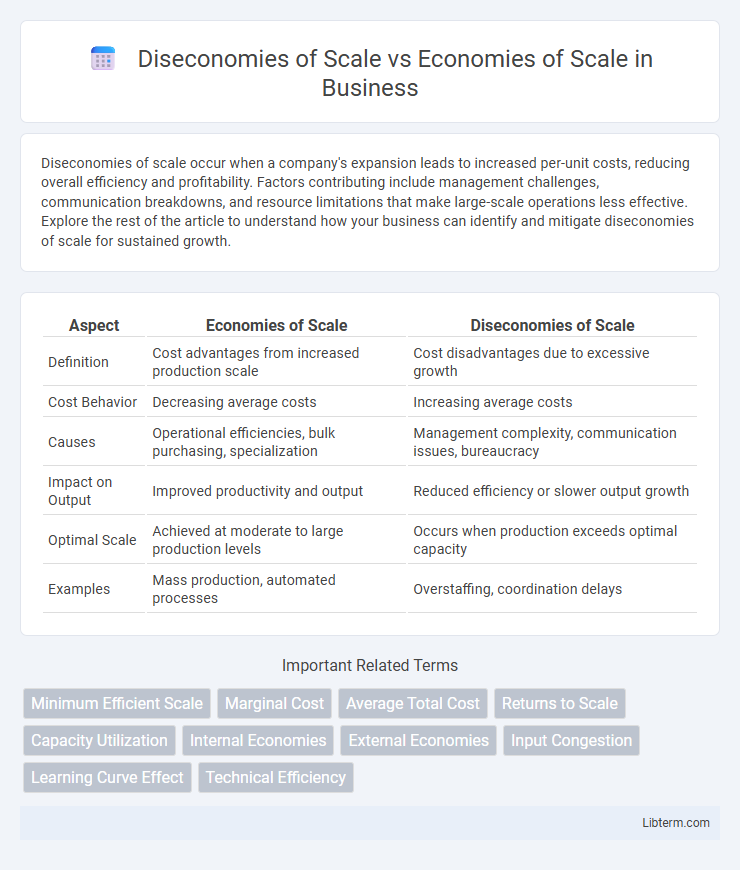Diseconomies of scale occur when a company's expansion leads to increased per-unit costs, reducing overall efficiency and profitability. Factors contributing include management challenges, communication breakdowns, and resource limitations that make large-scale operations less effective. Explore the rest of the article to understand how your business can identify and mitigate diseconomies of scale for sustained growth.
Table of Comparison
| Aspect | Economies of Scale | Diseconomies of Scale |
|---|---|---|
| Definition | Cost advantages from increased production scale | Cost disadvantages due to excessive growth |
| Cost Behavior | Decreasing average costs | Increasing average costs |
| Causes | Operational efficiencies, bulk purchasing, specialization | Management complexity, communication issues, bureaucracy |
| Impact on Output | Improved productivity and output | Reduced efficiency or slower output growth |
| Optimal Scale | Achieved at moderate to large production levels | Occurs when production exceeds optimal capacity |
| Examples | Mass production, automated processes | Overstaffing, coordination delays |
Introduction to Scale in Economics
Economies of scale occur when increasing production lowers the average cost per unit, enhancing efficiency and profitability for businesses. Diseconomies of scale arise when further expansion leads to higher per-unit costs due to factors like management inefficiencies and resource limitations. Understanding the balance between these concepts is crucial for optimizing production size and maintaining competitive advantage in economics.
Defining Economies of Scale
Economies of scale refer to the cost advantages that a business obtains due to expansion, leading to a reduction in average costs per unit as output increases. These cost savings arise from factors such as bulk purchasing, specialized labor, and improved technology or production techniques. In contrast, diseconomies of scale occur when a company grows too large, causing per-unit costs to rise due to inefficiencies like administrative complexity and communication breakdowns.
Key Types of Economies of Scale
Key types of economies of scale include internal economies such as technical, managerial, financial, and marketing efficiencies that reduce per-unit costs as production expands. Technical economies arise from specialized machinery and automated processes, while managerial economies come from improved supervision and division of labor. Diseconomies of scale occur when a firm's size surpasses optimal efficiency, leading to increased per-unit costs due to factors like bureaucratic delays, communication breakdowns, and resource misallocation.
Understanding Diseconomies of Scale
Diseconomies of scale occur when a company's production costs increase as its output expands beyond an optimal capacity, leading to inefficiencies and reduced profitability. Common causes include management challenges, communication breakdowns, and resource limitations that hinder operational effectiveness in large organizations. Understanding diseconomies of scale is crucial for businesses to maintain efficient growth and avoid the pitfalls of excessive expansion.
Causes of Diseconomies of Scale
Diseconomies of scale occur when increasing production leads to higher per-unit costs due to factors such as managerial inefficiencies, communication breakdowns, and overcomplex organizational structures. As firms expand, coordination challenges and bureaucratic delays increase, reducing operational efficiency and escalating costs. These causes contrast with economies of scale, where cost advantages arise from factors like bulk purchasing and specialized labor.
Comparative Analysis: Economies vs Diseconomies
Economies of scale occur when increased production lowers average costs due to factors like bulk purchasing, specialized labor, and efficient technology, enhancing overall profitability. Diseconomies of scale arise when further expansion leads to inefficiencies such as management complexity, communication breakdowns, and resource limitations, causing average costs to increase. Comparing the two highlights a cost-benefit curve where firms initially experience cost advantages that eventually reverse as operational scale exceeds optimal capacity.
Impact on Business Costs and Efficiency
Diseconomies of scale occur when a firm's expansion increases per-unit costs due to factors like management inefficiencies or resource limitations, reducing overall efficiency. Economies of scale lead to lower average costs as production volume increases, driven by factors such as bulk purchasing, specialized labor, and technological advantages. Understanding the balance between these effects helps businesses optimize costs and operational efficiency to maximize profitability.
Real-World Examples of Economies and Diseconomies
Economies of scale are evident in companies like Amazon, where increased production lowers average costs through bulk purchasing and streamlined logistics, enhancing efficiency. Conversely, diseconomies of scale appear in large corporations such as General Motors, where excessive size leads to communication breakdowns and managerial inefficiencies, increasing per-unit costs. Real-world examples highlight that while economies of scale boost competitiveness in growing firms, diseconomies arise when expansion surpasses optimal operational capacity.
Strategies to Manage Scale in Organizations
To manage economies and diseconomies of scale, organizations implement strategies such as decentralizing decision-making to enhance flexibility and reduce inefficiencies. Investing in advanced technology and automation improves operational productivity, allowing firms to exploit economies of scale while mitigating the negative impacts of complexity. Continuous process optimization and workforce training enable maintaining optimal scale by balancing cost advantages with organizational agility.
Conclusion: Balancing Growth and Efficiency
Achieving optimal firm performance requires balancing economies of scale, where cost per unit decreases with increased output, against diseconomies of scale, which cause costs to rise as firms grow too large. Effective management of operational complexity and communication channels mitigates diseconomies, sustaining efficiency at higher production levels. Strategic growth decisions depend on identifying the scale point that maximizes productivity without incurring escalating costs from inefficiencies.
Diseconomies of Scale Infographic

 libterm.com
libterm.com